Pop quiz! Circle in permanent marker directly on your screen:
TRUE OR FALSE: If you pick up a baby bird and return it to its nest, the mother won’t accept it.
TRUE OR FALSE: Once a penguin mates, the couple stays together forever.
TRUE OR FALSE: The more creative your pop-up’s headline is, the more emails you’ll capture.
I don’t know why most of those were bird-related, actually. But they’re all false. Also, if you have permanent marker circles on your screen, you really fail this test.
That piece of trivia about creative headlines? That’s just one of the many myths out there on list building.
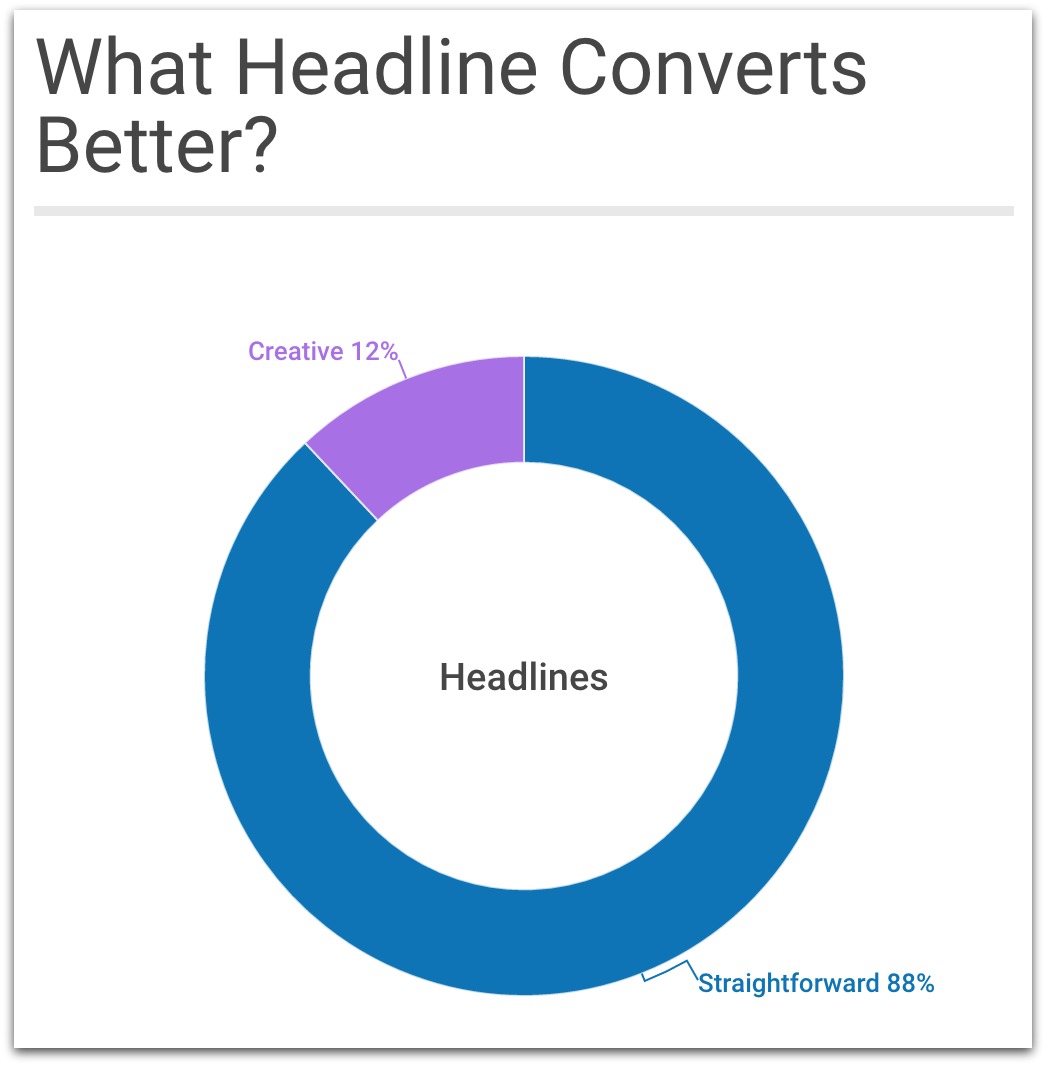
Pictured: Sweet, sweet proof
See, there are TONS of misconceptions around the topic of list building. And, just like any misconception, believing any one of them can really hurt you in the long run.
In this case, that means losing money and flushing a ton of your time down the drain. These myths can:
-
Hold you back from actually controlling your marketing vs. relying on someone else
-
Sink your conversion rates (even though they’re considered “best practices”)
-
Make you focus on the wrong goals (should you actually focus on the size of your list?)
That’s why I’ve taken the biggest misconceptions around list building and cleared them up with actionable steps you can take to build your own list.
Let’s get it.
When you decide to build your list, make sure you grab this free “Beginners List Building Bundle.” It’s got a 7-part class on list building, an automatic headline generator and a spreadsheet of our 35 favorite ways to get more email addresses.
Click here to get the bundle for free.
- List Building Myth #1: Popups Are Dying Out
- List Building Myth #2: You Can’t Collect Emails on Mobile Anymore
- List Building Myth #3: Asking Visitors to Sign Up For Your Newsletter Is A Good Idea
- List Building Myth #4: I Need to be Clever to Get More Subscribers
- List Building Myth #5: All Popups Are Too Aggressive
- List Building Myth #6: Popups Make People Leave My Site
- List Building Myth #7: The Bigger the List, the Better
- List Building Myth #8: List Building is Too Expensive
- List Building Myth #9: I Need to Collect As Much Information As Possible When Someone Opts-in
- List Building Myth #10: I’m Not Ready for List Building
- List Building Myth #11: I Can’t Build My List Without Having Emails Already Written
- List Building Myth #12: I Shouldn’t Make My Subscribers Confirm Their Subscription
- List Building Myth #13: Any Traffic is Good Traffic
List Building Myth #1: Popups Are Dying Out
A quick check on the ol’ interwebs and uh…
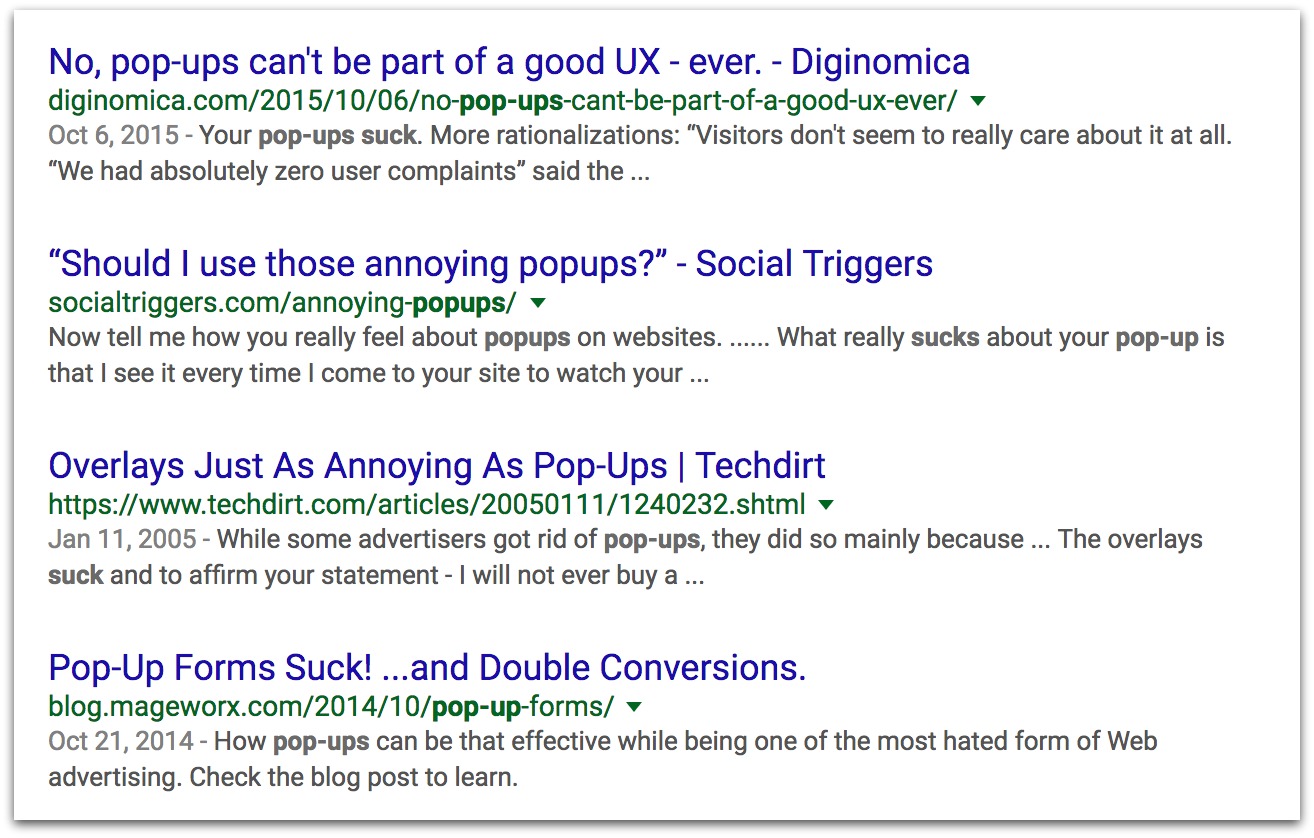
The sentiment on popups isn’t too kind. Ask any of your friends/coworkers/literally random strangers if they like popups and they’ll hiss like a vampire seeing the sun (probably).
Between popular opinion, articles on the internet and Google’s stance on “interstitials,” you’d think popups are in their dying days, right?
BUSTING THE MYTH
I’ll let this wrestler from Spiderman address the future of popups:

Let me assure you. Popups aren’t dying out at all.
Did you know Sumo users collected 23,645,948 email addresses the last two years with just List Builder pop-ups alone? That’s not even factoring in the emails from Smart Bar, Welcome Mat Scroll Box and other tools from our unnamed competitors.
So in the last two years one popup tool brought in the equivalent of Australia’s entire population in emails. Not bad, eh mate?
Pop-ups are here to stay for two reasons:
-
They work. Duh.
-
They’re getting smarter.
How are pop-ups getting smarter? Glad ya asked. Smarter popups have these two qualities in common:
-
They only show up in front of the right people: A popup is only as good as the person you’re showing it to. Popups are becoming more and more targeted, which means you can show a relevant offer to those visitors who actually care (as opposed to random tire-kickers).
-
They show at the right time: Great marketers know when their audience is most engaged. You can show popups at certain parts of a page, after a set amount of time or right before a reader leaves.
Popups have become so much more than annoying, flashing boxes that show up right when you visit a site. Facebook got smarter with their ads. Amazon got smarter with suggested items. Popups are now in that same realm in 2017.
They’re now no-brainer ways to grow your list rapidly.
List Building Myth #2: You Can’t Collect Emails on Mobile Anymore
For those that don’t know, in January Google released a new update to their mysterious ranking algorithm. In it, they basically said popups or screen-impeding tools that immediately appear on mobile will lower your site’s rank in Google searches.
Thanks, Obama.
No. Sorry, force of internet troll habit.
Thanks, Google.
Of all the list building myths floating around right now, this is the most annoying one. Ever since Google launched their announcement talking about list-capture tools on mobile, people lost their minds.

Since SEO is a big buzzword and Google rules the world (they’ve got a smartphone now!), people slowly but surely turned off their list building tools entirely.
BUSTING THE MYTH
Google’s algorithm is mysterious, and us commoners still don’t fully grasp all the factors that go into the ranking algorithm. This new mobile-focused change is no exception, and we’ll all be monitoring it in the coming months to pick out the true intricacies of the algorithm.
But there’s one thing we do know:
You can still collect emails on mobile devices without incurring a single Google-sized penalty. In fact, you should.
Why? Two reasons:
-
Your audience is coming from mobile.: 2016 marked the first year where mobile searches far surpassed desktop searches (60% to 40%, respectively). Ignoring your mobile traffic means missing at least 60% of potential new email subscribers.
-
Email is the only marketing channel you control: Facebook ads can change. SEO is always changing. Hell, paid ads could suddenly cost a ton. But your email list is yours. No matter what changes, you always have your list, and you can send traffic to anything you want.
-
So how do you collect emails on mobile without pissing off the big G?
There are six ways to do so, but the key is to create a popup that doesn’t immediately appear when a page loads on mobile.
And research shows that the best way to do this to collect emails like a boss is through a Click Trigger.
Click Triggers is the highest converting email collection strategy we use on Sumo. We see upwards of 60-70% conversion rates with Click Triggers:

Delicious
And they completely fall within the accepted standards of Google’s new mobile SEO rules.
A Click Trigger is just a popup that appears only when someone clicks a button or link:
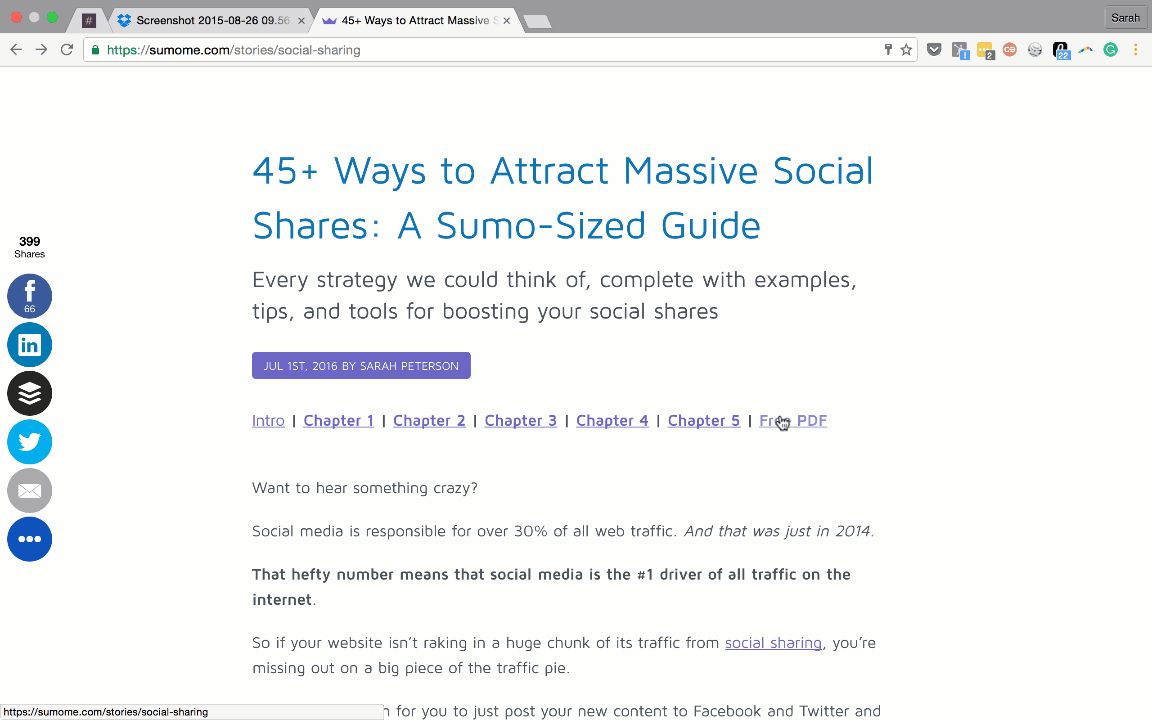
Instead of the popup appearing after a specific time, the click trigger only shows when someone chooses to see your offer.
Here’s what it looks like on mobile:
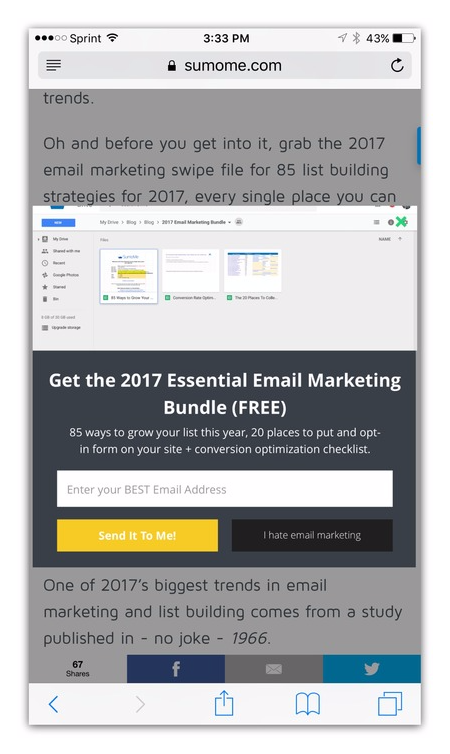
Don’t buy into this silly list building myth. As long as you’re smart about how you collect on mobile, you won’t feel the wrath of our Google overlords.
List Building Myth #3: Asking Visitors to Sign Up For Your Newsletter Is A Good Idea
You hear it all the time from list building gurus:
“Just set up a popup and ask people to sign up. It’s better than nothing, right?”
Wide eyed and bushy tailed (is that even a saying anymore?), you set up your first popup without changing a single thing. It looks something like this:
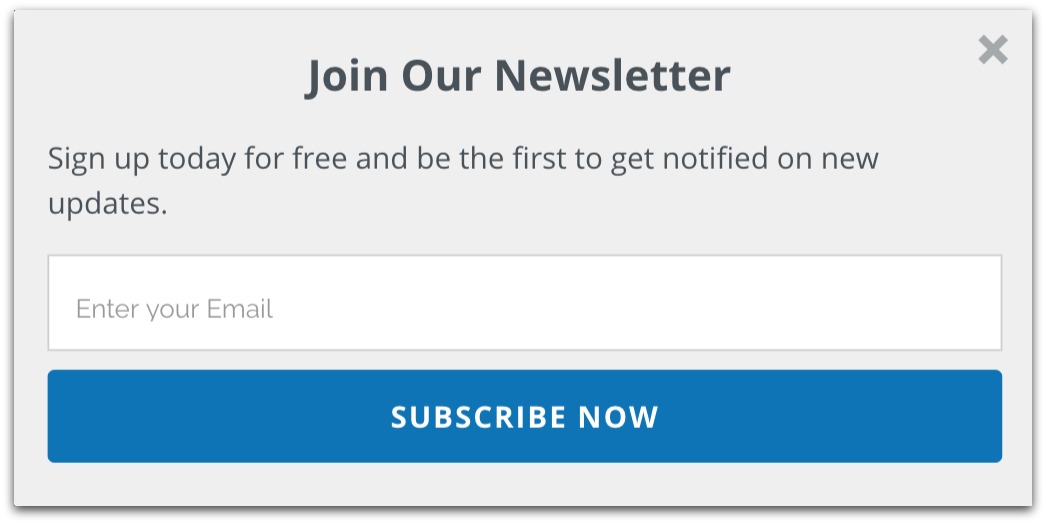
Awesome. You sit back, kick off your shoes and prepare yourself for the rush of emails coming your way.
BUSTING THE MYTH
Let’s be clear. Having some email addresses is better than no email addresses. But with the bare-bones popup like the one above, that’s what you’ll get — some emails.
It’s not enough to set a default popup and hope you collect a bunch of emails. You have to put in some effort to prove that your list is worth opting into. Asking someone to join yet another newsletter isn’t too appealing to most people.
Don’t believe me? Check this out:
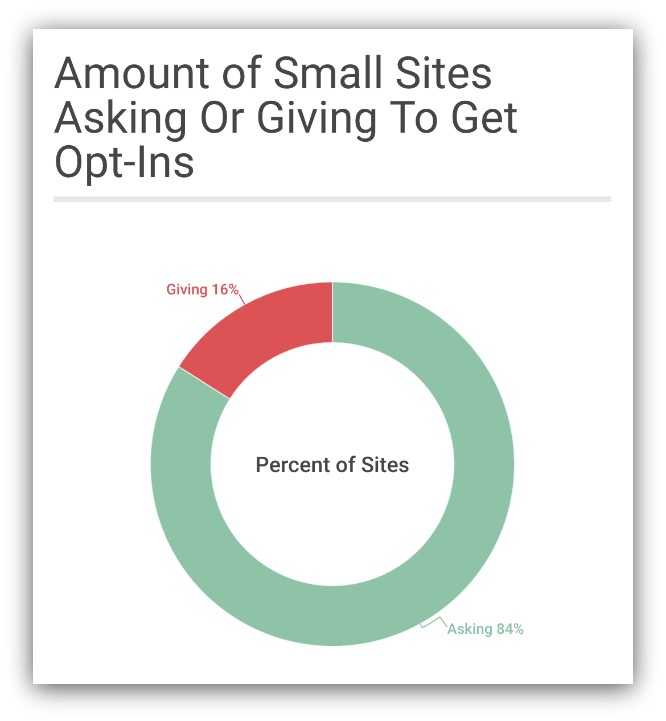
I conducted a study looking at opt-in strategies for different sized sites. The graph above looked at smaller sites (less than 5,000 visits) with horrible opt-in percentages (less than 1% of people opting in).
Guess what? The overwhelming majority of those sites asked for emails instead of giving something of value to the reader. Oh, and that trend held up for basically every size site imaginable.
If you want a bigger list, you need to give something of value to the reader in exchange for their email address. Discounts, content upgrades (our personal favorite), webinar registrations…they’re all great because they compel a reader to give you their email address.
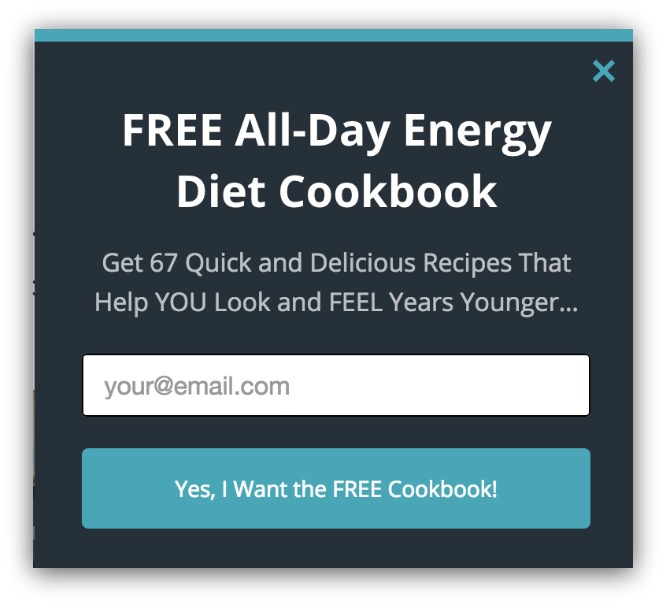
Great example of giving away value
Simply asking and doing the bare minimum? That won’t cut it anymore (and it’ll annoy your visitors).
List Building Myth #4: I Need to be Clever to Get More Subscribers
So you read the last myth and it came in loud and clear. Make a great popup that gives value. Got it.
What do you do? You spend an hour selecting the right template. Then more hours whipping up some crazy witty headline (or maybe you pay someone to do it). You read every article in existence to figure out what your call to action button should say.
After a few days…viola! You’re looking at a super creative, gorgeous popup. You turn it on and…
It’s a little, uh, disappointing. People see your popup, but they don’t opt-in — certainly not as many as you thought would, anyways. What gives?
BUSTING THE MYTH
Creativity does not equal more emails captured.
In the last myth, I talked about doing more than the bare minimum. But that refers to the value you give, not the popup that presents the value.
It’s like spending 10 hours wrapping a gift and there’s a stick inside the box. If what you’re giving away isn’t great, then it doesn’t matter how great the presentation is.
As a matter of fact, here’s one of the highest-converting popups of all time:
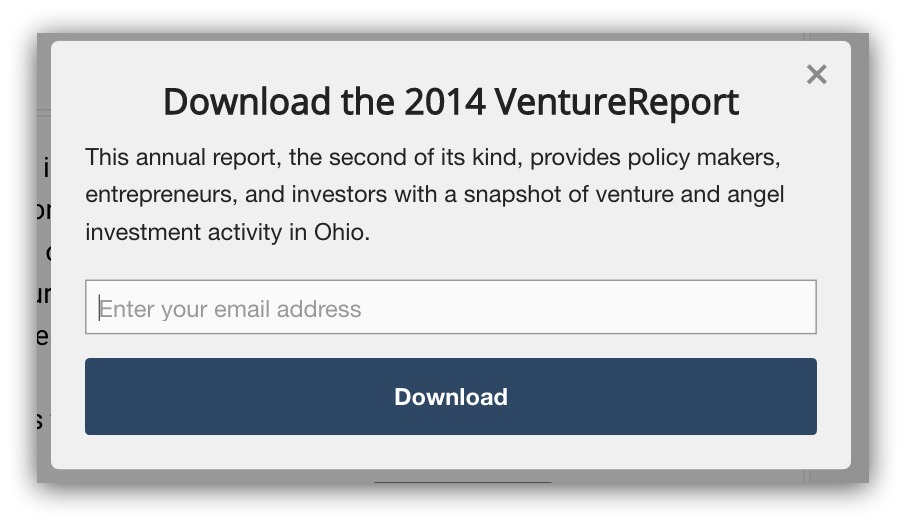
It’s not particularly flashy. And the headline isn’t very creative at all. But it converts like crazy.
Creativity, at least in popups, hurts you two ways:
-
You confuse your visitors: Confusion ensues you try too hard to come up with a creative headline. Confusion on a popup = exiting real quick.
-
You waste time: Coming up with creative text, images and all that jazz takes a lot of time. If you’re a small marketing team (or a team of 1) then you can’t justify that kind of time on a popup.
-
That last point is especially intriguing AND backed by science. We analyzed 150,000 popups and found that straightforward headlines beat creative ones almost every time:
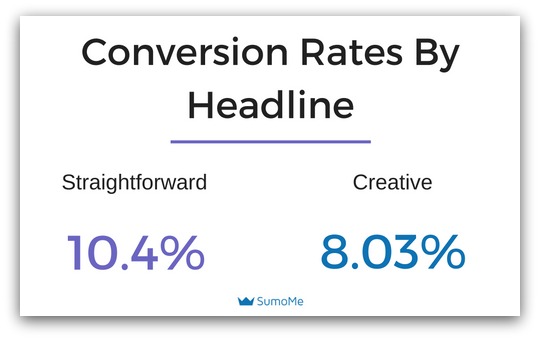
And here’s an example of what I mean when I say creative vs. straightforward headline:
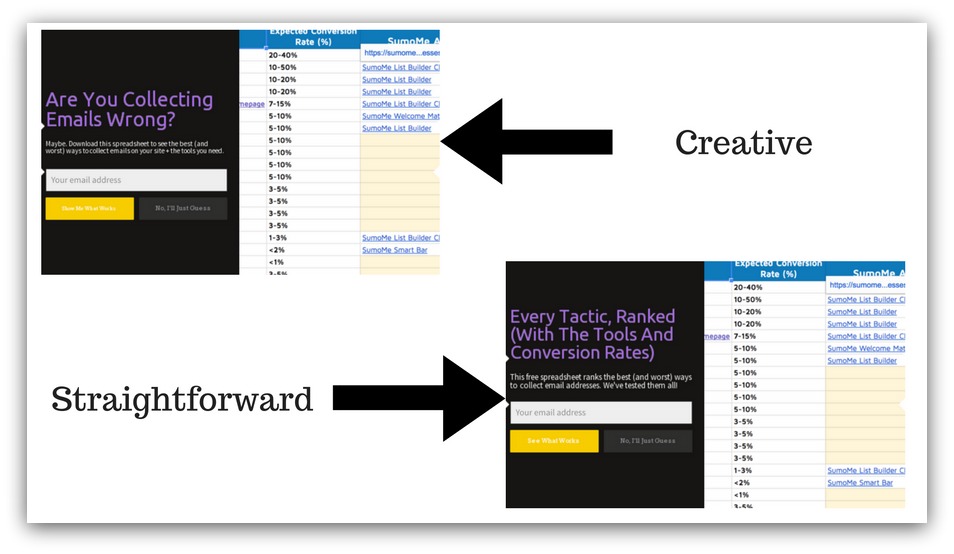
That creative headline you thought would slay your visitors? Turns out you’re getting less conversions than if you spent five seconds saying exactly what it is you’re giving away.
When it comes to popups, creativity is overrated. Generally, the more straightforward you are, the more emails you’ll collect.
List Building Myth #5: All Popups Are Too Aggressive
Personal question. Do you think this is annoying:
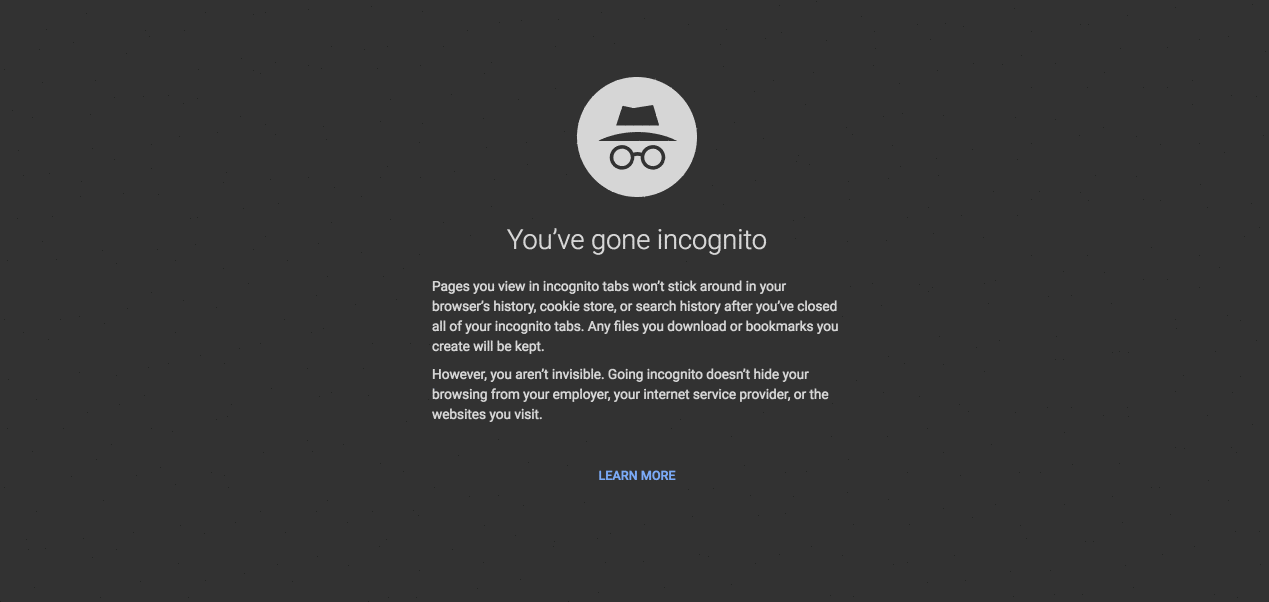
How much of that site did you get to read before the popup appeared? Probably 0% unless you’re one of those speed readers I see on TV.
And that’s how all popups are, right? They appear before you can read a single thing on a web page. In list building circles, that’s an aggressive popup — one that appears before you can interact with a site.
But are ALL popups really aggressive?
BUSTING THE MYTH
Of course not. That’s why it’s listed as a myth, after all. There are some popups that are classified as aggressive, but that’s only by choice.
In reality, it’s only a very small subset of popups that are considered aggressive. Check out all the stuff you can do to make a less-aggressive (but still extremely effective) popup:
Use Click Triggers
Click this. See the popup that appeared? That’s called a Click Trigger. It’s the least aggressive popup in existence because it only appears if the reader chooses to see it.
They have to click a link or button, which means they’re interested in what you’re offering. Only then will the popup appear.
Embed your popup
Don’t want the popup to appear at all? You can hide it in your content by embedding it:
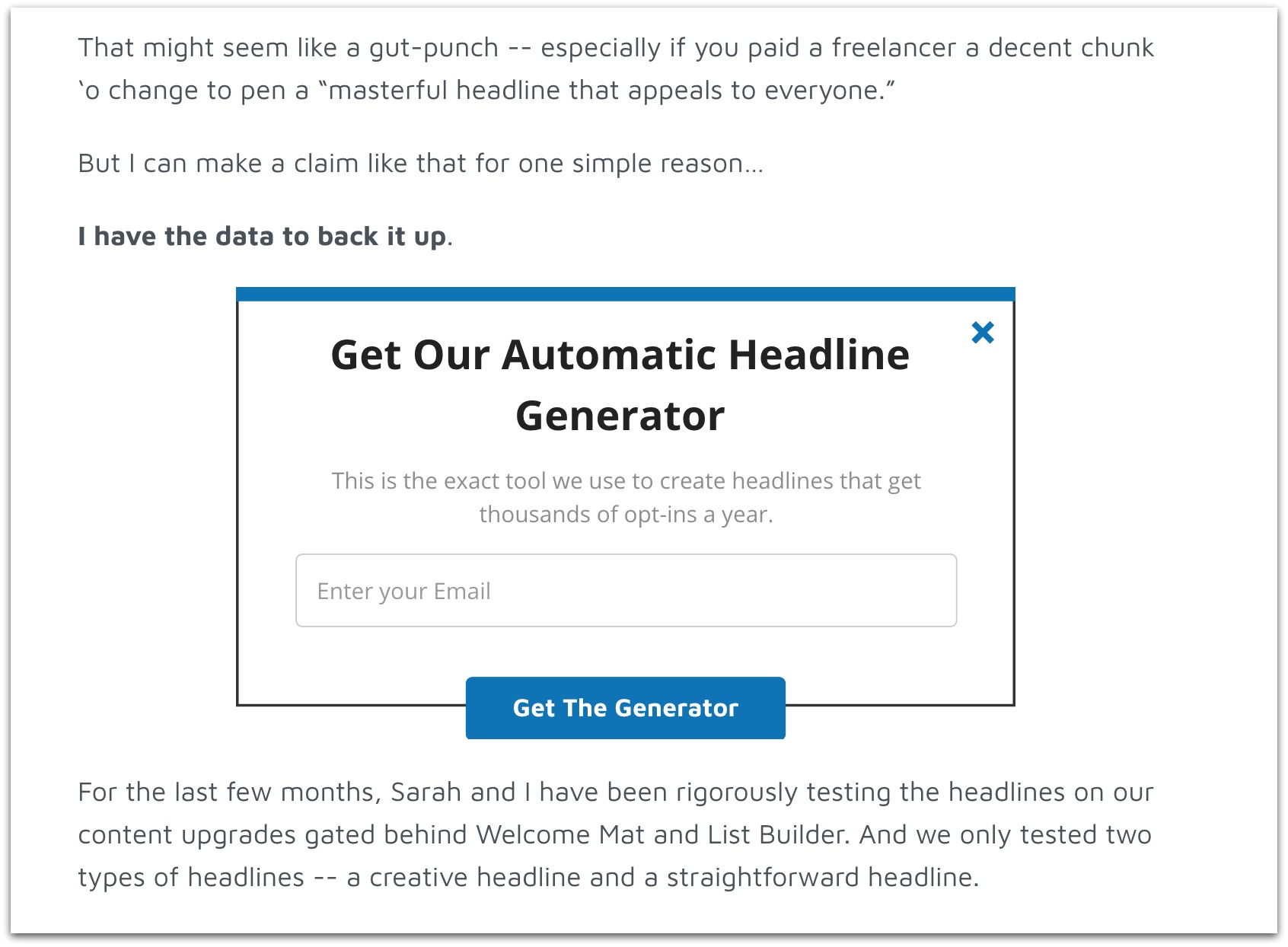
The popup never takes up the screen in an obtrusive way. It’s inserted directly into your content so readers can continue through your page in a seamless, uninterrupted way.
Use a Smart Bar
A Smart Bar is a bar (duh) that appears at the top of your website:
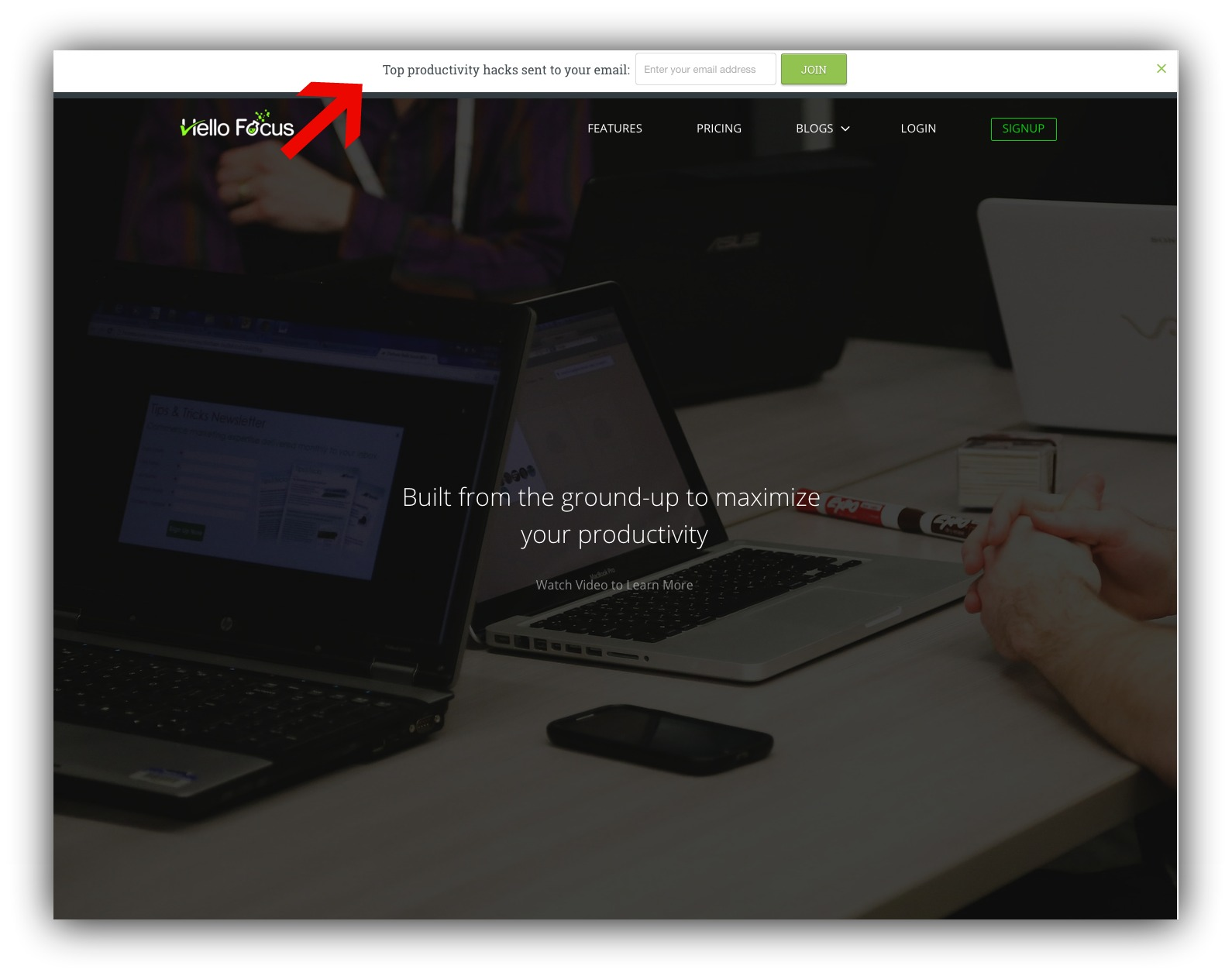
The bar stays out of the way, and can even disappear when your visitors scroll down the page. It’s a subtle yet effective take on the traditional popup.
Set your popup to appear later
If you love popups (and you should), but you don’t want them to appear right away, you can set a popup to appear after a certain time passes or percentage of your page is hit:
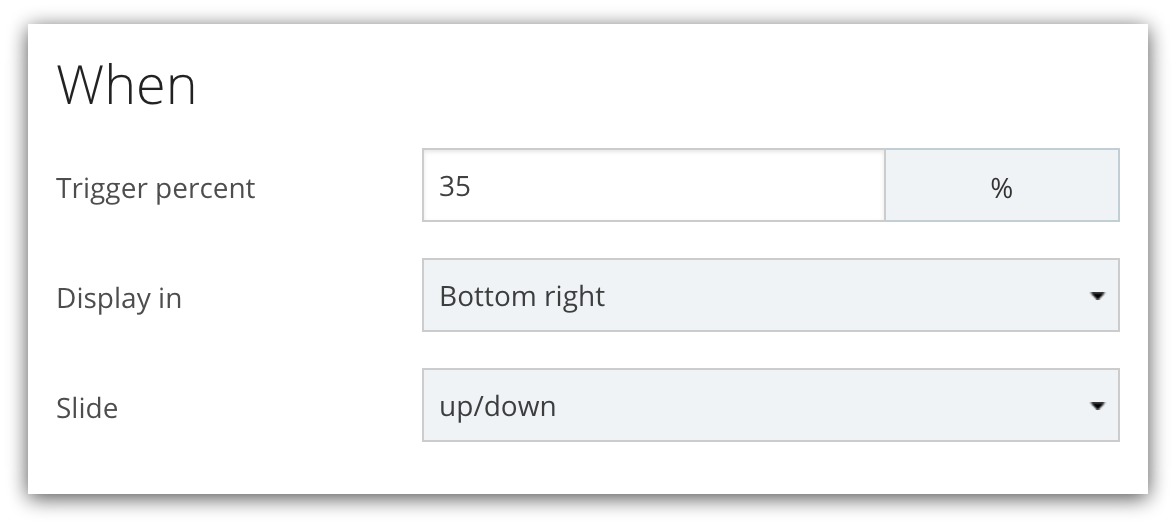
In this case, my popup wouldn’t show up until a visitor reached 35% of my page — right around the point of people being engaged.
We also rank the top 20 places to collect email addresses, but these are four of the best options for creating non-aggressive popups.
List Building Myth #6: Popups Make People Leave My Site
You’re afraid to setup any email capture tools because of something your friend said a while back:
“Yeah, some popup appeared on this thing I was reading and I was like ‘Ugh, THIS again.’ So I closed out and left that stupid site. THEN I WROTE A VERY LONG POST ON LINKEDIN COMPLAINING ABOUT…”
Alright, that last bit was embellishment on my part. But we’ve all at least heard something similar to the above remarks. People get annoyed with a popup and they leave your site. Then all that time you spent writing is thrown out the window because of that silly popup.
Or are they leaving because of something else?
BUSTING THE MYTH
This is one of the funniest myths to me. Everyone has this preconceived notion that every visitor reads every single word on every page they see.
That’s why I want you to ask yourself two serious questions:
1) Do you think people read your entire page anyways?
The answer comes in the form of a fully confident me screaming “NO” to every one of you from the other side of this computer. My co-workers are looking at me weirdly, but I don’t care.
Here’s the truth. It is a common occurrence for visitors to leave your blog/website/store without getting to the bottom of the page.
When we analyzed 650,000 blog visits to determine if people read an entire article, we found the average visitor would only read 25% of an article.
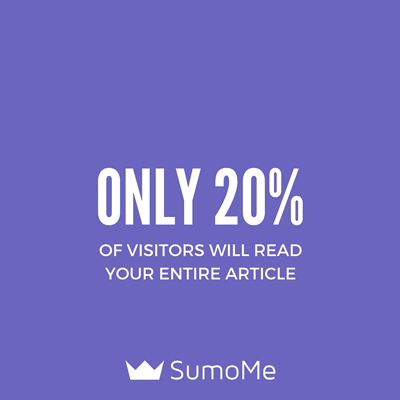
Then, when we analyzed what the best blog template was, we saw even the most successful sites couldn’t get more than 15% of readers through the entire page.
So no, people already aren’t reading your whole page. Which brings me to my second gut-check question…
2) Why do you want people to read your page?
Every one of your web pages has a goal. Usually, those goals aren’t centered around time on page. They’re around purchases, opt-ins and goals that generally move the needle for your company.
Using an email capture tool on your page is necessary. Collecting emails helps your business grow. If your content can build your list or get more purchases, then does it really matter if someone read your entire page?
Now, after all this, if you still (somehow) think popups will make your visitors leave, remember what I said before — smarter popups will win in 2017 and beyond.
You can take all the non-aggressive suggestions, pair them up with Content Analytics and do two “next level” things:
-
Make popups appear when people leave: Tools like List Builder can allow you to set a timed popup as well. With the Google Analytics plugin you can see how long the average visitor is on your page. Then you plug that time into the popup and it appears right before they leave.
-
Make popups appear where people leave: Content Analytics shows the exact point when most readers leave your page. You can pinpoint that spot, then either embed your popup there OR have your popup appear at that point.
-
Popups don’t make people leave pages. People leave pages anyways. By being smarter with your popups, you can avoid bothering them and making them leave your site.
List Building Myth #7: The Bigger the List, the Better
Which would you rather have? An email list of 10,000, or a list of 1,000?
Forget the “4 out of 5 dentists” bologna. Five out of five of you would choose the bigger list.
And why wouldn’t you? A bigger list means more opportunity to sell your product (or drive more traffic)… right?
But what if I told you to delete half your email list? I can practically hear you laughing on the other side of this screen.
That’s because you bought into this common list building myth: that the bigger your email list, the better.
BUSTING THE MYTH
Let’s rephrase that scenario in what my English professors would call a me-ta-phor.
You have two bags in front of you:
-
One contains 1,000 coins worth $1.00 each. It’s a guaranteed $1,000.
-
The other bag contains 5,000 coins. Those coins are a mix of dollars, quarters, dimes, pennies and some rocks. You don’t know how much that bag is actually worth. But it feels heavy.
Which one would you take? If you’re a gambler, you might take the bag with more stuff because the payoff could be greater.
The thing is, your email list isn’t something to gamble with. Here’s what happens if your big, fat list is full of fake emails, expired emails or just emails of unengaged people:
-
Your open rates plummet: Those awesome 30, 40, and 50% open rates you read about? Try 2-4% when your list is full of bad email addresses. What good is a massive list when only a handful of people open?
-
You get charged more money: Email service providers charge you more as your list grows. Plus, they charge for each email sent, so your bloated email list starts to put a massive dent in your pocket.
-
Your emails go undelivered: After you send a bunch of emails that repeatedly go unopened, your email service provider will mark you as “untrustworthy” and your emails will land in the spam folder.
So instead of focusing on a list built on quantity, focus on building a quality list. There’s a lot you can do to make sure your list is quality (instead of quantity), like using double opt-in for emails, sending automated emails and checking your list once a month to see who’s inactive.
And that quality list? It might seem smaller, but the engagement, traffic and sales you’ll get from it will dwarf anything you got from a bloated list twice the size.
List Building Myth #8: List Building is Too Expensive
“And for $600 a year you can use this tool to…”
“But sending emails is a snap when you upgrade to the paid plan for $1,200 a year…”
You read this all the time. And when you’re starting out, it seems like building a list is a damn expensive cause.
-
You need an email service provider.
-
You need a tool to collect emails.
-
You need to create cool stuff to give in exchange for an email.
When you sit back and add everything up, the costs turn your gung-ho attitude into fear-based lethargy. You just want to build your list, and you don’t have a lot of money laying around to experiment.
But is it really as expensive as you think?
BUSTING THE MYTH
Two friends in college had this similar dilemma, except it revolved around “getting swole” (which means working out, for the non-millennials).
Friend #1 wouldn’t work out unless he “did it right,” which meant getting a gym membership, a personal trainer and all the supplements. Friend #2 started doing some pushups, pull ups and planks every day.
Flash forward a few months and friend #1 hasn’t done anything while friend #2 fits in his high school jeans again.
You know who friend #2 was? Legendary martial artist Bruce Lee:

My roommate, Bruce Lee
Kidding. That friend’s name is Dan and he does insurance or something. But the point is this — You don’t need money to make progress.
It actually goes to another extreme with list building. Every day you don’t build your list, you lose money. But the good news is we’re living in the golden age of free list building. Almost every tool you need has a free level:
-
Email service provider: Mailchimp is free up to your first 2,000 subscribers AND they’re one of the most well-respected companies in the email space.
-
Place to capture emails: WordPress lets you create free sites in as little as 10 minutes.
-
Email capture tools: At Sumo we have the most powerful FREE list building tools on the internet. A/B testing, pre-made templates, click triggers…it’s all there, for free.
-
All this comes at the very affordable price of FREE. It’s a full “stack” that covers every part of list building you need — from driving traffic and capturing emails to storing and sending them.
Anyone can build a list for free. All it takes is a bit of your time.
List Building Myth #9: I Need to Collect As Much Information As Possible When Someone Opts-in
Have you heard anybody say this before?
“The more information you have on your subscribers, the more relevant messages you can send.”
And, as we know, the more relevant a message, the more likely someone is to buy.
Information is key. That’s why Amazon makes billions of dollars a year. They take what their knowledge of you as a consumer and offer products completely tailored to your life.
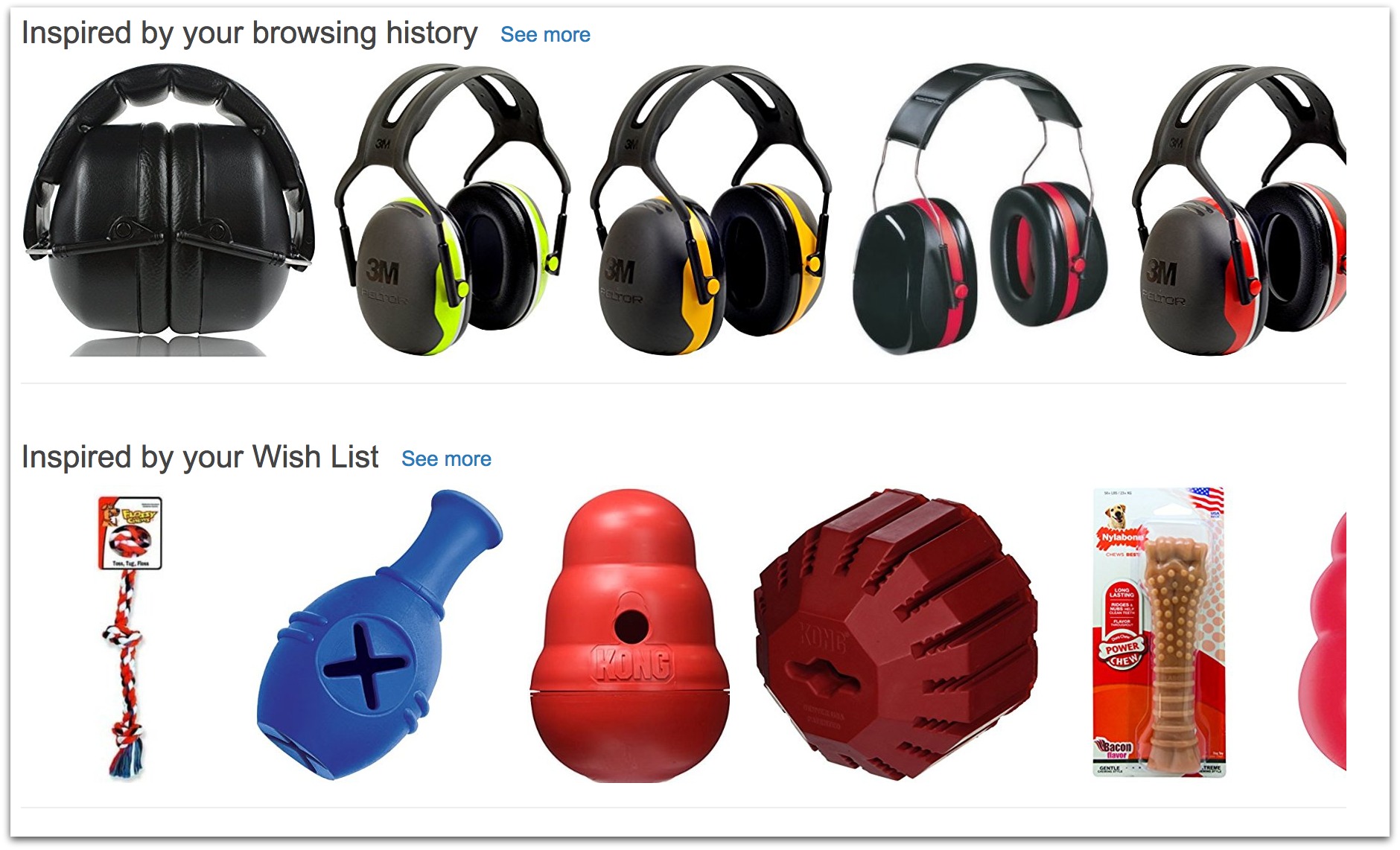
My life isn’t very quiet right now. Can you guess why?
So of course you want to gather tons of information on your new subscriber. That’s why you create a popup asking everything under the sun — name, email, phone number, residence, occupation, hobbies, favorite shows on Netflix.
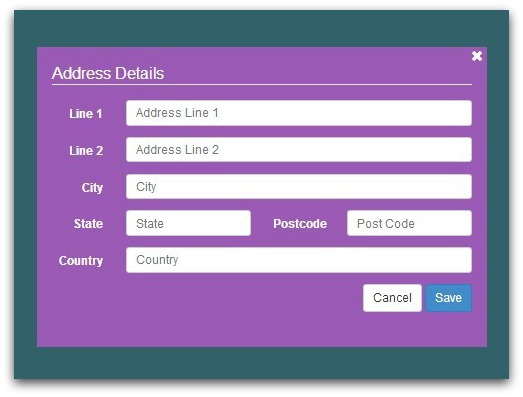
It feels like a census, but you’re confident all that information will make you an unstoppable marketer.
Right?
BUSTING THE MYTH
That popup you just created? The one with the seven fields?
Yeah. That’s not going to work well for you.
The general rule is this: the more form fields you include, the less opt-ins you’ll get.
Form fields act as barriers. For each one you include, you’re taking up more of your reader’s time. Imagine someone browsing your site during work, crunched on time because they have to fill out some spreadsheet or whatever.
Think they want to spend a ton of time giving you (an internet stranger) a bunch of their personal information?
That’s why most popups have 1-3 fields: email address, name and either phone number or something else that’s vital for contacting that person.
At Sumo, almost all our popups look like this:
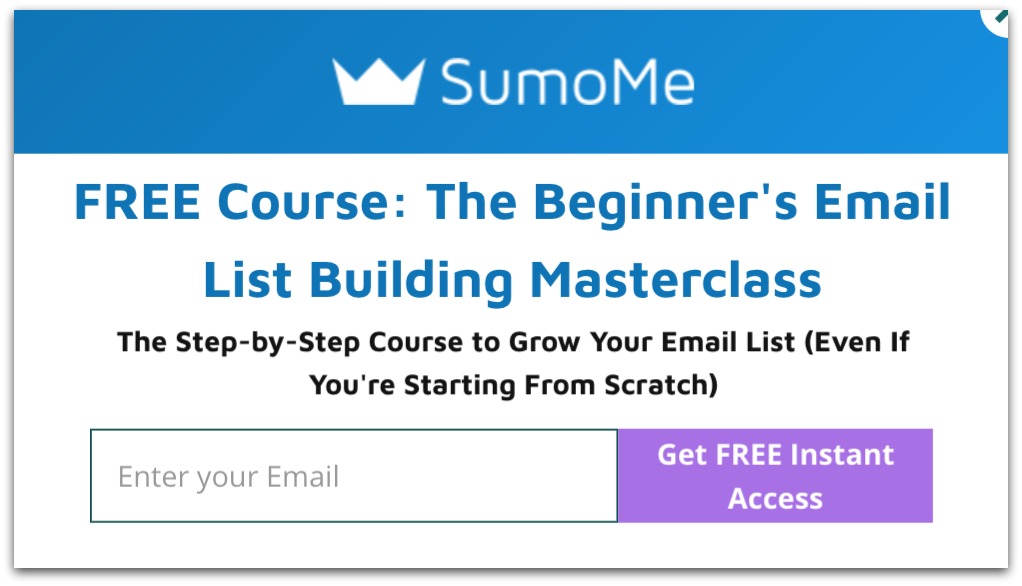
We only ask for an email address because that’s the most important information for us AND it provides a low barrier for the reader.
Because of that, we see conversion rates in the 70-90% range routinely. If someone is interested and wants to sign up for updates/content upgrades, you just need to get out of their way. The more you put in their path, the less likely they are to sign up.
List Building Myth #10: I’m Not Ready for List Building
“Who would want to sign up for something that doesn’t even exist?”
It makes sense. It’s like going into a Burger King and asking for a tofu burger. They don’t have it, but you still give them $5 so you can have one “when they get around to making one.”
It seems weird, and that’s what’s holding you back from collecting emails before your product is ready. You want everything to look professional, substantial and ready before you ask for some signups.
But do people really need all that before they give their email addresses?
BUSTING THE MYTH
Kickstarter heard this same objection and laughed as they ran to the bank with their business idea. Your product doesn’t have to be ready for you to capitalize on it.
Think of the thousands of people making money on Kickstarter without actually having anything ready to sell? Funny enough, Kickstarter actually took their business model from the online marketing realm because it works so well.
See, before preselling there was the widely known but seldom-used waiting list. Companies have done this for years, and it works like magic when you’re building a list.
I mean, if GOOGLE is doing it…
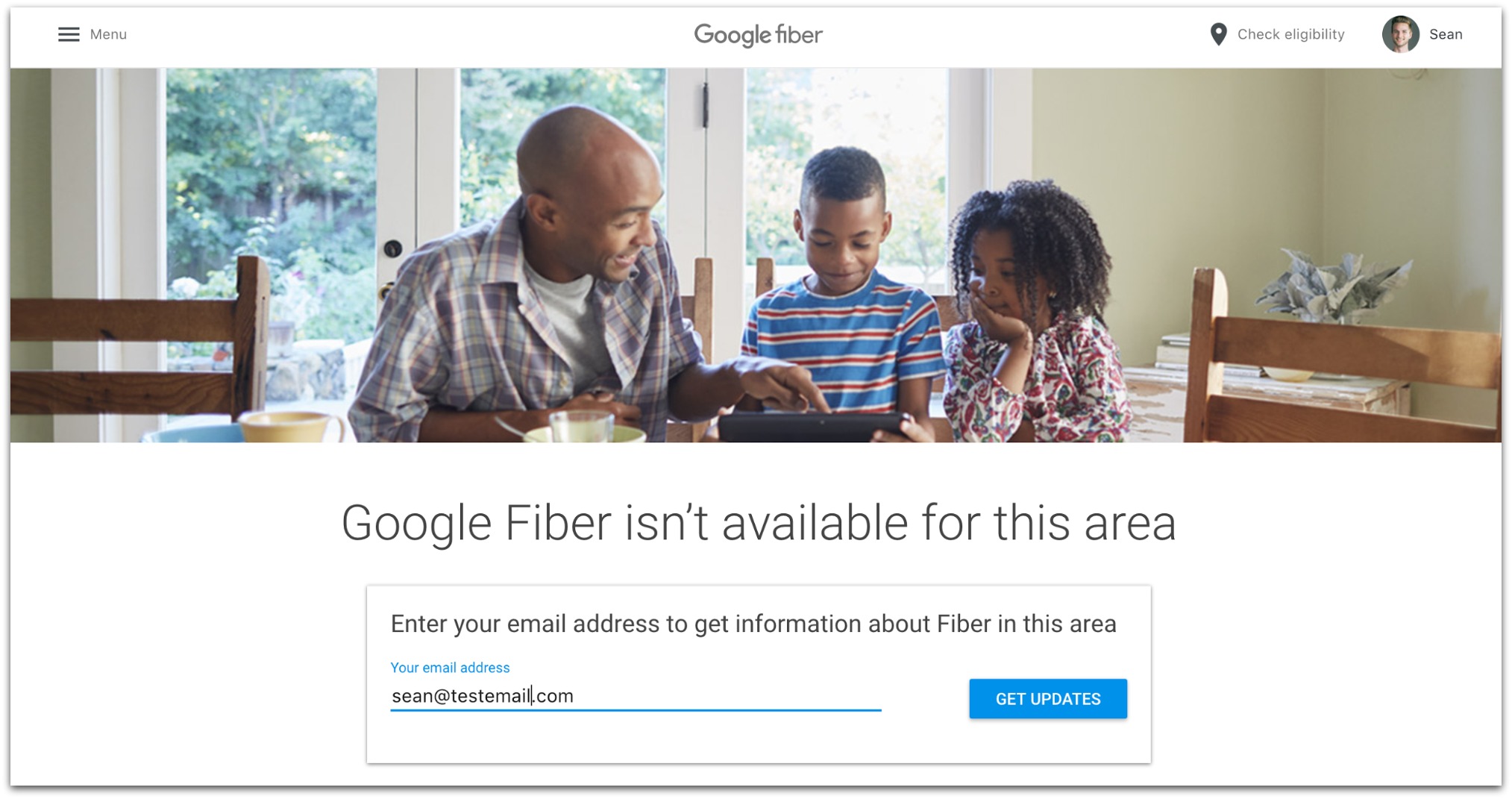
Then it must be working. You see this page if your city doesn’t have Google Fiber. You enter your email address and Google will notify you if there’s any chance in hell Fiber is coming to your city.
Google isn’t the only one collecting email addresses without a product to give:
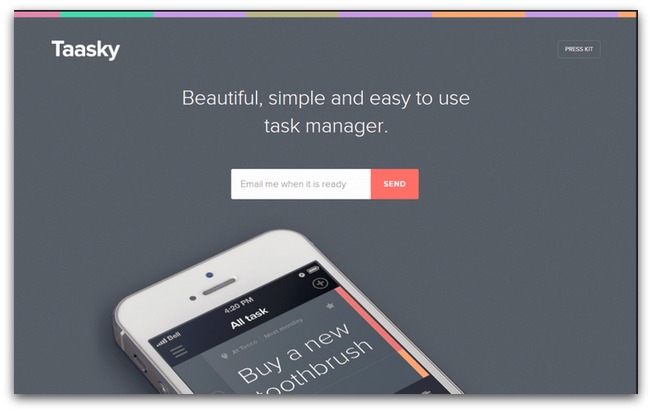
Here’s Taasky with a simple landing page that collects emails to notify people when the product is ready. And if you want a more powerful approach, you can get more signups by treating the page as a waiting list:
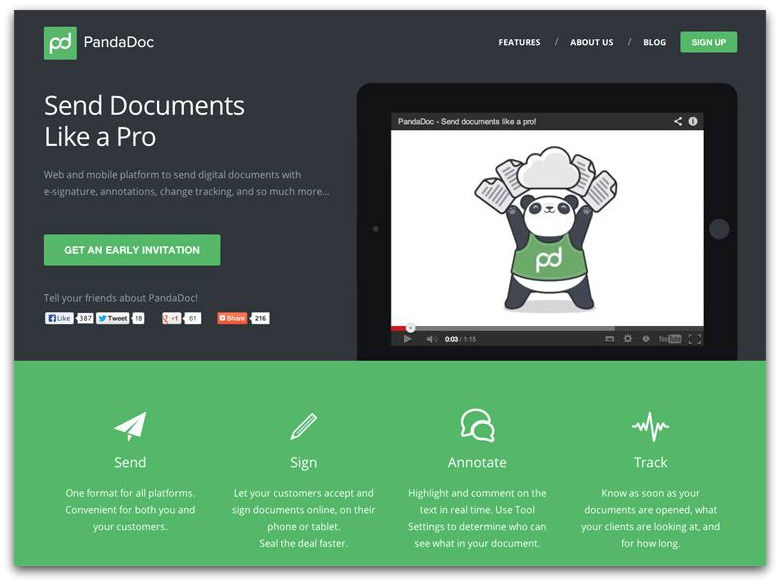
Here’s PandaDoc giving early invitations to people that sign up before the product is ready. This is a bit more powerful than a simple notification because you get the value of “being first” to use a product.
And it works for blog launches, too:
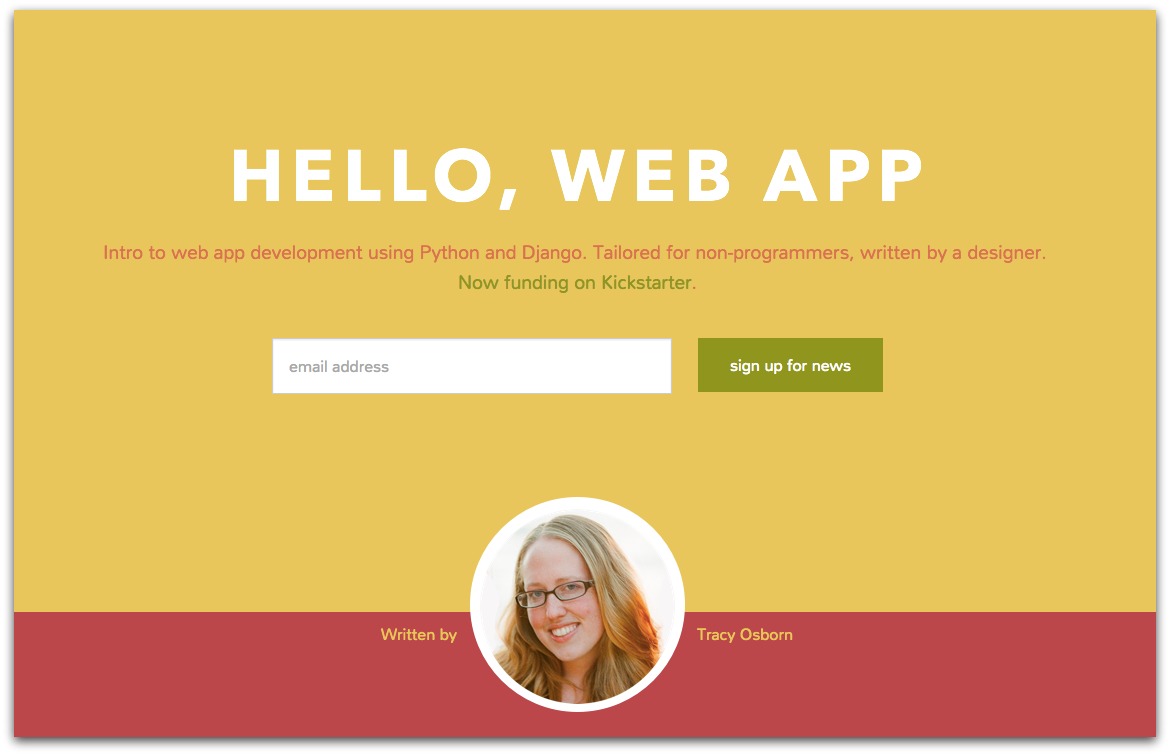
There was nothing on this blog (at the time). Yet Tracy still collected emails before she wrote one word for the blog.
The common thread? None of these products or blogs actually existed. Yet people still gave their email addresses to be notified or be first to use the product. You don’t need a finished product to capture email addresses right now.
You just need an idea and a page.
List Building Myth #11: I Can’t Build My List Without Having Emails Already Written
You’ve collected email addresses. Uh….now what? Do your subscribers just sit there and rot? Are they going to leave after a while? Will they ever buy anything!?
You hear about these large email sequences people build. Subscribers automatically get emails over days and weeks, eventually leading them to purchasing your product.
They take a long time to build. But they’re extremely effective. So why capture email addresses if you can’t sit back and let your automated marketing machine convert them into customers?
BUSTING THE MYTH
If you’re just starting out with list building, don’t worry — you’re in the same boat as 51% of even professional marketers.
Here’s what happens when you start out trying to build a big automated system:
-
You get confused and quit: There are people whose job it is to strictly focus on building up these systems. It’s a highly specialized thing to do, and if you’re a beginner you could get frustrated and give up email marketing altogether.
-
You end up redoing your automation, anyways: You’re just starting out. You have no idea what your audience will respond to. If you build this massive system, a few weeks down the road you’ll realize your messages don’t match what your audience wants.
Instead of waiting until you have a big system in place, focus on providing immediate value through smaller automation.
Here’s what I mean. Your subscribers want instant gratification more than anything. Giving away an email address is like giving away a phone number at a bar — it’s pretty guarded, and if you give it you want that person to talk to you.
So forego the huge email automation machine and send one simple email after someone subscribes. Two of the most popular ones are:
-
The Welcome Email: You’re just saying “hey” in this email, welcoming the subscriber to your community and letting them know what to expect.
-
The Content Delivery Email: If your subscriber opted-in to get a content upgrade, this email can deliver that piece of additional content.
Those are the two most common automatic emails you would send when someone first signs up to your list (though there are 13 other email types).
As for how to send that simple automated email? You can either set it up in your email service provider, or you can use the free Auto Responder feature in the Sumo tools.
That’s right. You don’t even need an email service provider to send automated emails. With Auto Responder, you can set up an email FOR FREE and it’ll automatically send to any new subscriber.
It’s the small wins like one automated email that end up being more meaningful than all that time you’d spend building a massive email system.
List Building Myth #12: I Shouldn’t Make My Subscribers Confirm Their Subscription
It seems like a hassle. And it seems counterintuitive.
You worked hard to get a reader to subscribe to your list. And now you’re sending an email containing a link they have to click if they really want to subscribe?
Oh, and if they don’t click that link, you can’t email them. Ever.
So why in the world would you ever want to make someone confirm their subscription?
BUSTING THE MYTH
The method I just described is called the double opt-in method. See, there are two ways people can join an email list:
-
Single Opt-In: You ask for a visitor to join your list. They give you their email. Ta-da — they’re part of your list.
-
Double Opt-In: You ask a visitor to join your list. They give you their email. You send an email with a link they have to click in order to actually get emails from you.
Double opt-in seems like more work. But there’s nothing I’d recommend more when you’re starting your list building adventures.
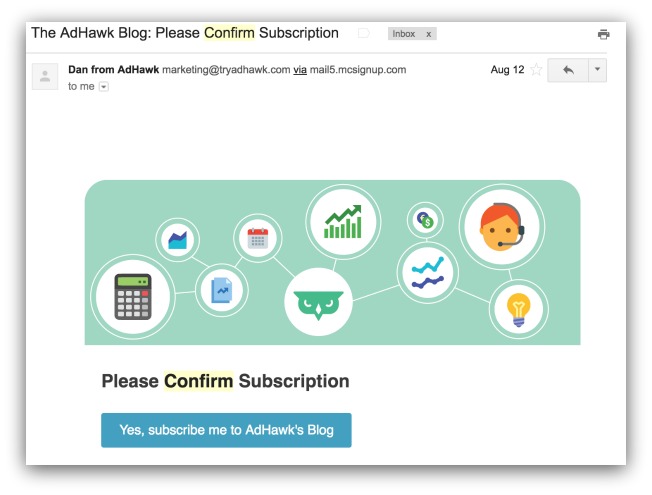
A double opt-in email
It goes back to one of the myths we busted: bigger vs. smaller lists. With single opt-in, you get a bigger list because you’re not vetting anyone. However, you aren’t protecting yourself against:
-
Email typos: This is the most honest and common mistake imaginable. Someone enters their email address but messes up one letter, and suddenly you have a fake address on your hands. Double opt-in prevents typos by delivering to the email address given.
-
Bots: Same as the above scenario. Except I’ve seen malicious marketers send bots to rival marketing sites to tank their email lists. No bueno.
-
Fake addresses: If you’re giving away a content upgrade, people enter in fake addresses to get the content. Double opt-in prevents new fake addresses from hitting your list.
-
So while it seems like a hassle, you’re actually protecting yourself and building a stronger email list by using double opt-in. Every email service provider gives the option of turning that on (it’s literally a flick of a switch), so I suggest doing that when you’re building your list.
List Building Myth #13: Any Traffic is Good Traffic
Traffic is traffic, right?
You spend time creating an awesome offer. Then you put it on a popup that appears alllllll over your site so everyone can reap the rewards of your generosity.
Traffic is traffic, and the more of it you can drive to your popup, the better. Because, who wouldn’t want your broad offer that appeals to everyone?
BUSTING THE MYTH
Here’s the deal. Your offers are usually going to appeal to a small subset of people at a time.
To give you an example, we have a popup that got us 2,000 new email addresses. But the guide it was on had 15,000 visitors. While that’s still a crazy high conversion rate, that means 13,000 people still didn’t dig our offer.
No matter how good your offer is, there will be a majority of people that don’t want it. That’s why you need to find the right people to show your offer to. Not only will it perform better, but it’ll prevent uninterested visitors from being annoyed.
Here’s an example. Say I showed this popup to you:
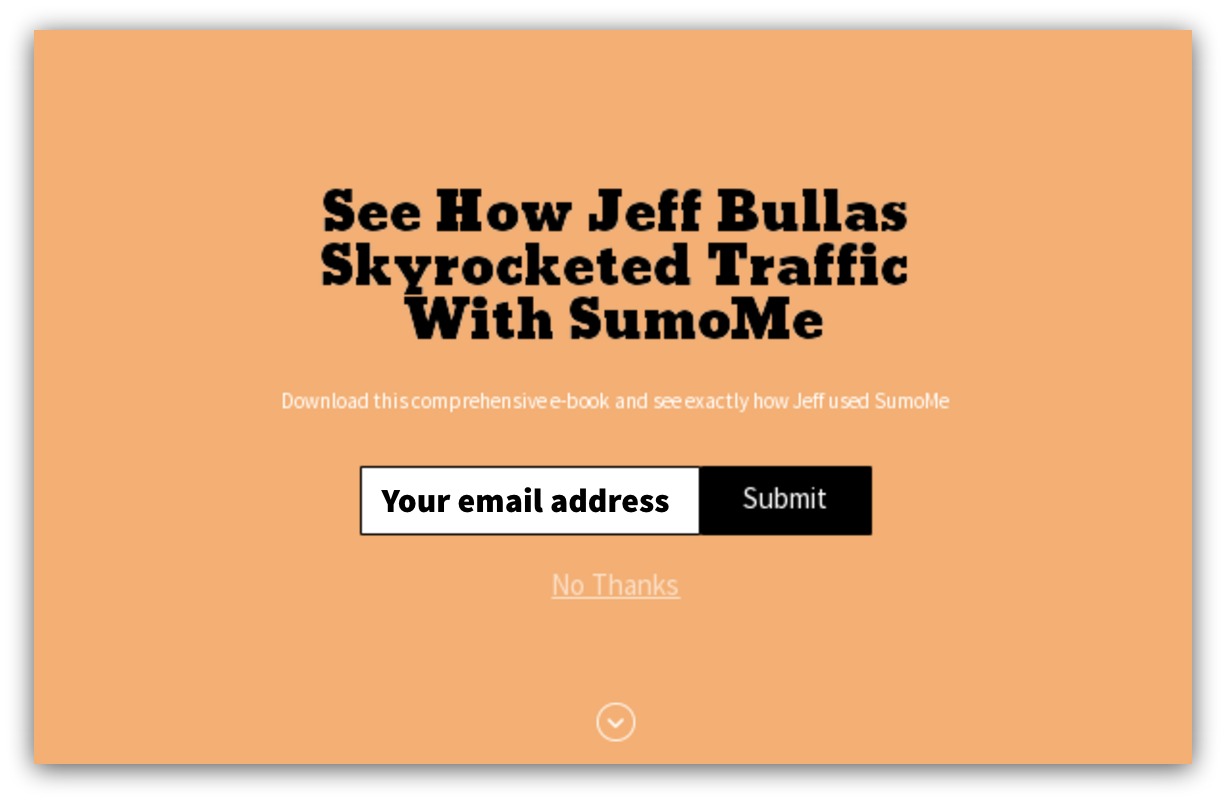
That probably doesn’t interest you (though it should, it’s a great ebook). But that’s because you’re a general audience — you may or may not know who Jeff Bullas is, which is what the offer hinges on.
However, if I targeted people coming to the Sumo site from Jeff’s site, that offer would look damn appealing.
And guess what? I’m absolutely able to do that within Sumo tools:
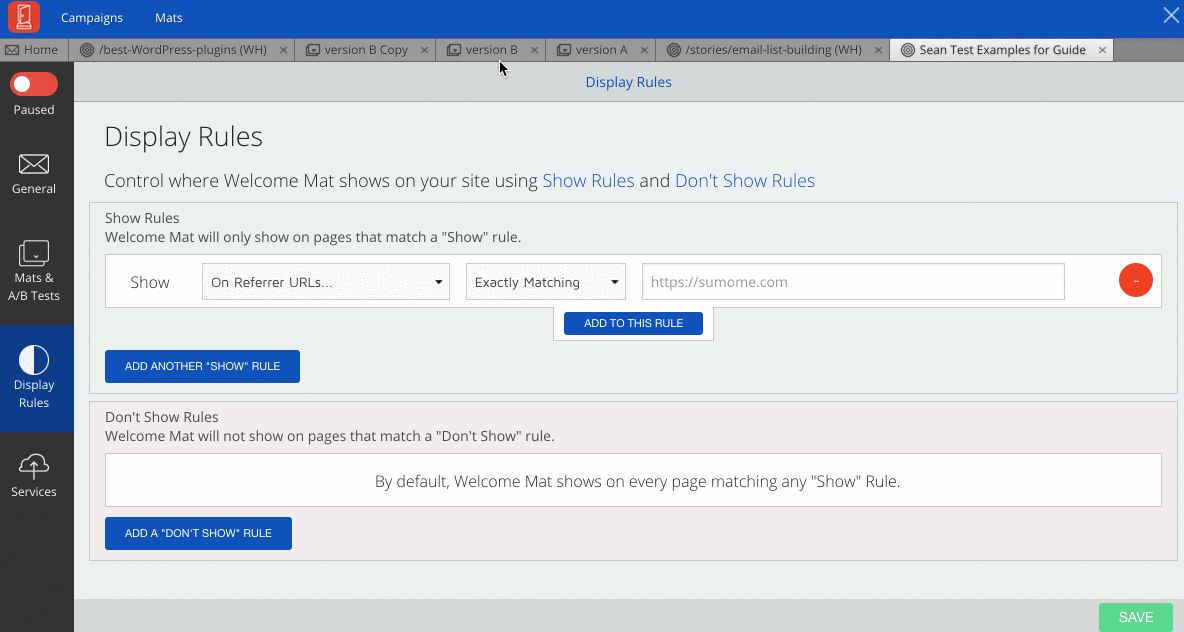
I created a rule where that popup will only show to visitors coming from Jeff Bullas’ site. That makes this popup highly targeted, which would explain why it has a high conversion rate.
There are tons of rules you can use to segment and target your audience within Sumo. All you have to do is choose one or two and you’ll see your email list grow like mad because you’re being smarter with your popups.
Here’s A Free List Building Kit To Get You Started
So you want to build your list today. Awesome! I wanna help you out. I put together a beginner list building kit that’s full of the best resources we’ve ever created:
-
Email Marketing Masterclass: A free 7-part lesson on everything you need to know about sending emails — from selecting an email service provider to getting your first 100 subscribers.
-
-
The Top 34 Ways to Increase Your Conversion Rates Spreadsheet: These are the same tips we used to grow our list to 750,000.
-
The Automatic Headline Generator: Enter a few pieces of information and our generator will automatically spit out high-converting headlines for your popup.
-
Add A Comment
VIEW THE COMMENTS